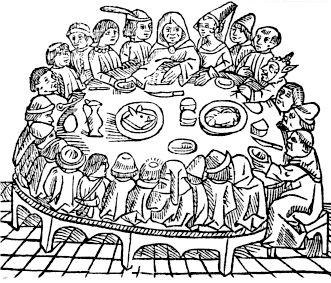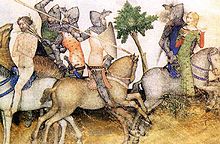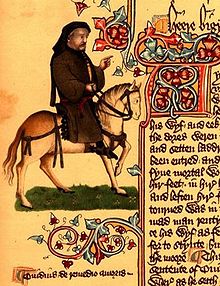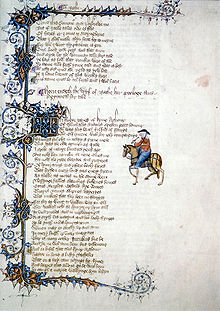
The Canterbury Tales
Background Information
SOS believes education gives a better chance in life to children in the developing world too. All children available for child sponsorship from SOS Children are looked after in a family home by the charity. Read more...
The Canterbury Tales is a collection of stories written in Middle English by Geoffrey Chaucer at the end of the 14th century. The tales (mostly written in verse, although some are in prose) are presented as part of a story-telling contest by a group of pilgrims as they travel together on a journey from Southwark to the shrine of Saint Thomas Becket at Canterbury Cathedral. The prize for this contest is a free meal at the Tabard Inn at Southwark on their return.
After a long list of works written earlier in his career, including Troilus and Criseyde, House of Fame, and " Parliament of Fowls", The Canterbury Tales was Chaucer's magnum opus. He uses the tales and the descriptions of its characters to paint an ironic and critical portrait of English society at the time, and particularly of the Church. Structurally, the collection resembles The Decameron, which Chaucer may have read during his first diplomatic mission to Italy in 1372.
It is sometimes argued that the greatest contribution that this work made to English literature was in popularizing the literary use of the vernacular, English, rather than French or Latin. English had, however, been used as a literary language for centuries before Chaucer's life, and several of Chaucer's contemporaries— John Gower, William Langland, and the Pearl Poet—also wrote major literary works in English. It is unclear to what extent Chaucer was responsible for starting a trend rather than simply being part of it. Also, while Chaucer clearly states the addressees of many of his poems (the Book of the Duchess is believed to have been written for John of Gaunt on the occasion of his wife's death in 1368), the intended audience of The Canterbury Tales is more difficult to determine. Chaucer was a courtier, leading some to believe that he was mainly a court poet who wrote exclusively for nobility.
Text
The question of whether The Canterbury Tales is finished has not yet been answered. There are 83 known manuscripts of the work from the late medieval and early Renaissance period, more than any other vernacular literary text with the exception of The Prick of Conscience. This is taken as evidence of the tales' popularity during the century after Chaucer's death. Fifty-five of these manuscripts are thought to have been complete at one time, while 28 are so fragmentary that it is difficult to ascertain whether they were copied individually or as part of a set. The Tales vary in both minor and major ways from manuscript to manuscript; many of the minor variations are due to copyists' errors, while others suggest that Chaucer added to and revised his work as it was being copied and (possibly) distributed.
Even the earliest surviving manuscripts are not Chaucer's originals, the oldest being MS Peniarth 392 D (called " Hengwrt"), compiled by a scribe shortly after Chaucer's death. The most beautiful of the manuscripts of the tales is the Ellesmere Manuscript, and many editors have followed the order of the Ellesmere over the centuries, even down to the present day. The first version of The Canterbury Tales to be published in print was William Caxton's 1478 edition. Since this print edition was created from a now-lost manuscript, it is counted as among the 83 manuscripts.
Order
No authorial, unarguably complete version of the Tales exists and no consensus has been reached regarding the order in which Chaucer intended the stories to be placed.
Textual and manuscript clues have been adduced to support the two most popular modern methods of ordering the tales. Some scholarly editions divide the Tales into ten "Fragments". The tales that comprise a Fragment are closely related and contain internal indications of their order of presentation, usually with one character speaking to and then stepping aside for another character. However, between Fragments, the connection is less obvious. Consequently, there are several possible orders; the one most frequently seen in modern editions follows the numbering of the Fragments (ultimately based on the Ellesmere order). Victorians frequently used the nine "Groups", which was the order used by Walter William Skeat whose edition Chaucer: Complete Works was used by Oxford University Press for most of the twentieth century, but this order is now seldom followed.
| Fragment | Group | Tales |
|---|---|---|
| Fragment I | A | General Prologue, Knight, Miller, Reeve, Cook |
| Fragment II | B1 | Man of Law |
| Fragment III | D | Wife of Bath, Friar, Summoner |
| Fragment IV | E | Clerk, Merchant |
| Fragment V | F | Squire, Franklin |
| Fragment VI | C | Physician, Pardoner |
| Fragment VII | B2 | Shipman, Prioress, Sir Thopas, Melibee, Monk, Nun's Priest |
| Fragment VIII | G | Second Nun, Canon's Yeoman |
| Fragment IX | H | Manciple |
| Fragment X | I | Parson |
An alternative ordering (seen in an early manuscript containing the Canterbury Tales, the early-fifteenth century Harley MS. 7334) places Fragment VIII before VI. Fragments I and II almost always follow each other, as do VI and VII, IX and X in the oldest manuscripts. Fragments IV and V, by contrast are located in varying locations from manuscript to manuscript.
Language
Although no manuscript exists in Chaucer's own hand, two were copied around the time of his death by Adam Pinkhurst, a scribe with whom he seems to have worked closely before, giving a high degree of confidence that Chaucer himself wrote the Tales. Chaucer's generation of English-speakers was among the last to pronounce e at the end of words (so for Chaucer the word "care" was pronounced [ˈkaːrə], not / ˈ k ɛər / as in modern English). This meant that later copyists tended to be inconsistent in their copying of final -e and this for many years gave scholars the impression that Chaucer himself was inconsistent in using it. It has now been established, however, that -e was an important part of Chaucer's morphology (having a role in distinguishing, for example, singular adjectives from plural and subjunctive verbs from indicative). The pronunciation of Chaucer's writing otherwise differs most prominently from Modern English in that his language had not undergone the Great Vowel Shift: pronouncing Chaucer's vowels as they would be pronounced today in European languages like Italian, Spanish or German generally produces pronunciations more like Chaucer's own than Modern English pronunciation would. In addition, sounds now written in English but not pronounced were still pronounced by Chaucer: the word
|
|
|
Genre and structure

Canterbury Tales is a collection of stories built around a frame narrative or frame tale, a common and already long established genre of its period. Chaucer's Tales differs from most other story "collections" in this genre chiefly in its intense variation. Most story collections focused on a theme, usually a religious one. Even in the Decameron, storytellers are encouraged to stick to the theme decided on for the day. The idea of a pilgrimage to get such a diverse collection of people together for literary purposes was also unprecedented, though "the association of pilgrims and storytelling was a familiar one". Introducing a competition among the tales encourages the reader to compare the tales in all their variety, and allows Chaucer to showcase the breadth of his skill in different genres and literary forms.
While the structure of the Tales is largely linear, with one story following another, it is also much more than that. In the General Prologue, Chaucer describes, not the tales to be told, but the people who will tell them, making it clear that structure will depend on the characters rather than a general theme or moral. This idea is reinforced when the Miller interrupts to tell his tale after the Knight has finished his. Having the Knight go first, gives one the idea that all will tell their stories by class, with the Knight going first, followed by the Monk, but the Miller's interruption makes it clear that this structure will be abandoned in favour of a free and open exchange of stories among all classes present. General themes and points of view arise as tales are told which are responded to by other characters in their own tales, sometimes after a long lapse in which the theme has not been addressed.
Lastly, Chaucer does not pay much attention to the progress of the trip, to the time passing as the pilgrims travel, or specific locations along the way to Canterbury. His writing of the story seems focused primarily on the stories being told, and not on the pilgrimage itself.
Style
The variety of Chaucer's tales shows the breadth of his skill and his familiarity with countless rhetorical forms and linguistic styles. Medieval schools of rhetoric at the time encouraged such diversity, dividing literature (as Virgil suggests) into high, middle, and low styles as measured by the density of rhetorical forms and vocabulary. Another popular method of division came from St. Augustine, who focused more on audience response and less on subject matter (a Virgilian concern). Augustine divided literature into "majestic persuades", "temperate pleases", and "subdued teaches". Writers were encouraged to write in a way that kept in mind the speaker, subject, audience, purpose, manner, and occasion. Chaucer moves freely between all of these styles, showing favoritism to none. He not only considers the readers of his work as an audience, but the other pilgrims within the story as well, creating a multi-layered rhetorical puzzle of ambiguities. Chaucer's work thus far surpasses the ability of any single medieval theory to uncover.
With this Chaucer avoids targeting any specific audience or social class of readers, focusing instead on the characters of the story and writing their tales with a skill proportional to their social status and learning. However, even the lowest characters, such as the Miller, show surprising rhetorical ability, although their subject matter is more lowbrow. Vocabulary also plays an important part, as those of the higher classes refer to a woman as a "lady", while the lower classes use the word "wenche", with no exceptions. At times the same word will mean entirely different things between classes. The word "pitee", for example, is a noble concept to the upper classes, while in the Merchant's Tale it refers to sexual intercourse. Again, however, tales such as the Nun's Priest's Tale show surprising skill with words among the lower classes of the group, while the Knight's Tale is at times extremely simple.
Chaucer uses the same meter throughout almost all of his tales, with the exception of Sir Thopas and his prose tales. It is a decasyllable line, probably borrowed from French and Italian forms, with riding rhyme and, occasionally, a caesura in the middle of a line. His meter would later develop into the heroic meter of the 15th and 16th centuries and is an ancestor of iambic pentameter. He avoids allowing couplets to become too prominent in the poem, and four of the tales (the Man of Law's, Clerk's, Prioress', and Second Nun's) use rhyme royal.
Historical context and themes
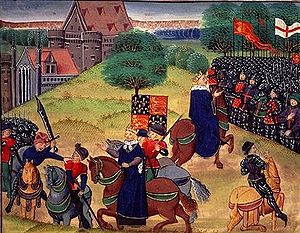
The Canterbury Tales was written during a turbulent time in English history. The Catholic Church was in the midst of the Western Schism and, though it was still the only Christian authority in Europe, was the subject of heavy controversy. Lollardy, an early English religious movement led by John Wycliffe, is mentioned in the Tales, as is a specific incident involving pardoners (who gathered money in exchange for absolution from sin) who nefariously claimed to be collecting for St. Mary Rouncesval hospital in England. The Canterbury Tales is among the first English literary works to mention paper, a relatively new invention which allowed dissemination of the written word never before seen in England. Political clashes, such as the 1381 Peasants' Revolt and clashes ending in the deposing of King Richard II, further reveal the complex turmoil surrounding Chaucer in the time of the Tales' writing. Many of his close friends were executed and he himself was forced to move to Kent in order to get away from events in London.
In 2004, Professor Linne Mooney was able to identify the scrivener who worked for Chaucer as an Adam Pinkhurst. Mooney, then a professor at the University of Maine and a visiting fellow at Corpus Christi College, Cambridge, was able to match Pinkhurst's signature, on an oath he signed, to his lettering on a copy of The Canterbury Tales that was transcribed from Chaucer's working copy. While some readers look to interpret the characters of "The Canterbury Tales" as historical figures, other readers choose to interpret its significance in less literal terms. After analysis of his diction and historical context, his work appears to develop a critique against society during his lifetime. Within a number of his descriptions, his comments can appear complimentary in nature, but through clever language, the statements are ultimately critical of the pilgrim’s actions. It is unclear whether Chaucer would intend for the reader to link his characters with actual persons. Instead, it appears that Chaucer creates fictional characters to be general representations of people in such fields of work. With an understanding of medieval society, one can detect subtle satire at work.
Religion
The Tales reflect diverse views of the Church in Chaucer's England. After the Black Death, many Europeans began to question the authority of the established Church. Some turned to lollardy, while others chose less extreme paths, starting new monastic orders or smaller movements exposing church corruption in the behaviour of the clergy, false church relics or abuse of indulgences. Several characters in the Tales are religious figures, and the very setting of the pilgrimage to Canterbury is religious (although the prologue comments ironically on its merely seasonal attractions), making religion a significant theme of the work.
Two characters, the Pardoner and the Summoner, whose roles apply the church's secular power, are both portrayed as deeply corrupt, greedy, and abusive. A pardoner in Chaucer's day was a person from whom one bought Church "indulgences" for forgiveness of sins, but pardoners were often thought guilty of abusing their office for their own gain. Chaucer's Pardoner openly admits the corruption of his practice while hawking his wares. The Summoner is a Church officer who brought sinners to the church court for possible excommunication and other penalties. Corrupt summoners would write false citations and frighten people into bribing them in order to protect their interests. Chaucer's Summoner is portrayed as guilty of the very kinds of sins he is threatening to bring others to court for, and is hinted as having a corrupt relationship with the Pardoner. In The Friar's Tale, one of the characters is a summoner who is shown to be working on the side of the devil, not God.
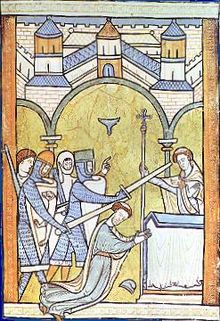
Churchmen of various kinds are represented by the Monk, the Prioress, the Nun's Priest, and the Second Nun. Monastic orders, which originated from a desire to follow an ascetic lifestyle separated from the world, had by Chaucer's time become increasingly entangled in worldly matters. Monasteries frequently controlled huge tracts of land on which they made significant sums of money, while peasants worked in their employ. The Second Nun is an example of what a Nun was expected to be: her tale is about a woman whose chaste example brings people into the church. The Monk and the Prioress, on the other hand, while not as corrupt as the Summoner or Pardoner, fall far short of the ideal for their orders. Both are expensively dressed, show signs of lives of luxury and flirtatiousness and show a lack of spiritual depth. The Prioress's Tale is an account of Jews murdering a deeply pious and innocent Christian boy, a blood libel against Jews which became a part of English literary tradition. The story did not originate in the works of Chaucer and was well known in the 14th century.
Pilgrimage was a very prominent feature of medieval society. The ultimate pilgrimage destination was Jerusalem, but within England Canterbury was a popular destination. Pilgrims would journey to cathedrals that preserved relics of saints, believing that such relics held miraculous powers. Saint Thomas Becket, Archbishop of Canterbury, had been murdered in Canterbury Cathedral by knights of Henry II during a disagreement between Church and Crown. Miracle stories connected to his remains sprang up soon after his death, and the cathedral became a popular pilgrimage destination. The pilgrimage in the work ties all of the stories together, and may be considered a representation of Christians' striving for heaven, despite weaknesses, disagreement, and diversity of opinion.
Social class and convention
The upper class or nobility, represented chiefly by the Knight and his Squire, was in Chaucer's time steeped in a culture of chivalry and courtliness. Nobles were expected to be powerful warriors who could be ruthless on the battlefield, yet mannerly in the King's Court and Christian in their actions. Knights were expected to form a strong social bond with the men who fought alongside them, but an even stronger bond with a woman whom they idealized in order to strengthen their fighting ability. Though the aim of chivalry was to noble action, often its conflicting values degenerated into violence. Church leaders often tried to place restrictions on jousts and tournaments, which at times ended in the death of the loser. The Knight's Tale shows how the brotherly love of two fellow knights turns into a deadly feud at the sight of a woman whom both idealize, with both knights willing to fight the other to the death in order to win her. Chivalry was in Chaucer's day on the decline, and it is possible that The Knight's Tale was intended to show its flaws, although this is disputed. Chaucer himself had fought in the Hundred Years' War under Edward III, who heavily emphasized chivalry during his reign. Two tales, Sir Topas and The Tale of Melibee are told by Chaucer himself, who is travelling with the pilgrims in his own story. Both tales seem to focus on the ill-effects of chivalry—the first making fun of chivalric rules and the second warning against violence.
The Tales constantly reflect the conflict between classes. For example, the division of the three estates; the characters are all divided into three distinct classes, the classes being "those who pray" (the clergy), "those who fight" (the nobility), and "those who work" (the commoners and peasantry). Most of the tales are interlinked by common themes, and some "quit" (reply to or retaliate against) other tales. Convention is followed when the Knight begins the game with a tale, as he represents the highest social class in the group. But when he is followed by the Miller, who represents a lower class, it sets the stage for the Tales to reflect both a respect for and a disregard for upper class rules. Helen Cooper, as well as Mikhail Bakhtin and Derek Brewer, call this opposition "the ordered and the grotesque, Lent and Carnival, officially approved culture and its riotous, and high-spirited underside." Several works of the time contained the same opposition.
Relativism versus realism
Chaucer's characters each express different—sometimes vastly different—views of reality, creating an atmosphere of relativism. As Helen Cooper says, "Different genres give different readings of the world: the fabliau scarcely notices the operations of God, the saint's life focuses on those at the expense of physical reality, tracts and sermons insist on prudential or orthodox morality, romances privilege human emotion." The sheer number of varying persons and stories renders the Tales as a set unable to arrive at any definite truth or reality.
Influence on literature
It is sometimes argued that the greatest contribution that this work made to English literature was in popularizing the literary use of the vernacular, English, rather than French or Latin. English had, however, been used as a literary language for centuries before Chaucer's life, and several of Chaucer's contemporaries— John Gower, William Langland, and the Pearl Poet—also wrote major literary works in English. It is unclear to what extent Chaucer was responsible for starting a trend rather than simply being part of it. It is interesting to note that, although Chaucer had a powerful influence in poetic and artistic terms, which can be seen in the great number of forgeries and mistaken attributions (such as The Flower and the Leaf which was translated by John Dryden), modern English spelling and orthography owes much more to the innovations made by the Court of Chancery in the decades during and after his lifetime.
Reception
While Chaucer clearly states the addressees of many of his poems (the Book of the Duchess is believed to have been written for John of Gaunt on the occasion of his wife's death in 1368), the intended audience of The Canterbury Tales is more difficult to determine. Chaucer was a courtier, leading some to believe that he was mainly a court poet who wrote exclusively for the nobility. He is referred to as a noble translator and poet by Eustache Deschamps and by his contemporary John Gower. It has been suggested that the poem was intended to be read aloud, which is probable as this was a common activity at the time. However, it also seems to have been intended for private reading as well, since Chaucer frequently refers to himself as the writer, rather than the speaker, of the work. Determining the intended audience directly from the text is even more difficult, since the audience is part of the story. This makes it difficult to tell when Chaucer is writing to the fictional pilgrim audience or the actual reader.
Chaucer's works may have been distributed in some form during his lifetime in part or in whole. Scholars speculate that manuscripts were circulated among his friends, but likely remained unknown to most people until after his death. However, the speed with which copyists strove to write complete versions of his tale in manuscript form shows that Chaucer was a famous and respected poet in his own day. The Hengwrt and Ellesmere manuscripts are examples of the care taken to distribute the work. More manuscript copies of the poem exist than for any other poem of its day except The Prick of Conscience, causing some scholars to give it the medieval equivalent of "best-seller" status. Even the most elegant of the illustrated manuscripts, however, is not nearly as decorated and fancified as the work of authors of more respectable works such as John Lydgate's religious and historical literature.
15th century
John Lydgate and Thomas Occleve were among the first critics of Chaucer's Tales, praising the poet as the greatest English poet of all time and the first to show what the language was truly capable of poetically. This sentiment was universally agreed upon by later critics into the mid-15th century. Glosses included in Canterbury Tales manuscripts of the time praised him highly for his skill with "sentence" and rhetoric, the two pillars by which medieval critics judged poetry. The most respected of the tales was at this time the Knight's, as it was full of both.
Literary additions and supplements
The incompleteness of the Tales led several medieval authors to write additions and supplements to the tales in order to make them more complete. Some of the oldest existing manuscripts of the tales include new or modified tales, showing that even early on, such additions were being created. These emendations included various expansions of the Cook's Tale, which Chaucer never finished, The Plowman's Tale, The Tale of Gamelyn, the Siege of Thebes, and the Tale of Beryn.
The Tale of Beryn, written by an anonymous author in the 15th century, is preceded by a lengthy prologue in which the pilgrims arrive at Canterbury and their activities there are described. While the rest of the pilgrims disperse throughout the town, the Pardoner seeks the affections of Kate the barmaid, but faces problems dealing with the man in her life and the innkeeper Harry Bailey. As the pilgrims turn back home, the Merchant restarts the storytelling with Tale of Beryn. In this tale, a young man named Beryn travels from Rome to Egypt to seek his fortune only to be cheated by other businessmen there. He is then aided by a local man in getting his revenge. The tale comes from the French tale Bérinus and exists in a single early manuscript of the tales, although it was printed along with the tales in a 1721 edition by John Urry.
John Lydgate wrote The Siege of Thebes in about 1420. Like the Tale of Beryn, it is preceded by a prologue in which the pilgrims arrive in Canterbury. Lydgate places himself among the pilgrims as one of them and describes how he was a part of Chaucer's trip and heard the stories. He characterizes himself as a monk and tells a long story about the history of Thebes before the events of the Knight's Tale. John Lydgate's tale was popular early on and exists in old manuscripts both on its own and as part of the tales. It was first printed as early as 1561 by John Stow and several editions for centuries after followed suit.
There are actually two versions of The Plowman's Tale, both of which are influenced by the story Piers Plowman, a work written during Chaucer's lifetime. Chaucer describes a Plowman in the General Prologue of his tales, but never gives him his own tale. One tale, written by Thomas Occleve, describes the miracle of the Virgin and the Sleeveless Garment. Another tale features a pelican and a griffin debating church corruption, with the pelican taking a position of protest akin to John Wycliffe's ideas.
The Tale of Gamelyn was included in an early manuscript version of the tales, Harley 7334, which is notorious for being one of the lower-quality early manuscripts in terms of editor error and alteration. It is now widely rejected by scholars as an authentic Chaucerian tale, although some scholars think he may have intended to rewrite the story as a tale for the Yeoman. Dates for its authorship vary from 1340–1370.
Literary adaptations
Many literary works (both fiction and non-fiction alike) have used a similar frame narrative to The Canterbury Tales as an homage. Science fiction writer Dan Simmons wrote his Hugo Award winning novel Hyperion based on an extra-planetary group of pilgrims. Evolutionary biologist Richard Dawkins used The Canterbury Tales as a structure for his 2004 non-fiction book about evolution titled The Ancestor's Tale: A Pilgrimage to the Dawn of Evolution. His animal pilgrims are on their way to find the common ancestor, each telling a tale about evolution.
Henry Dudeney's book The Canterbury Puzzles contains a part reputedly lost from what modern readers know as Chaucer's tales.
Historical mystery novelist P.C. Doherty wrote a series of novels based on The Canterbury Tales, making use of the story frame and of Chaucer's characters.
Canadian author Angie Abdou translates The Canterbury Tales to a cross section of people, all snow sports enthusiasts but from different social backgrounds, converging on a remote backcountry ski cabin in British Columbia in the 2011 novel The Canterbury Trail.
Stage and film adaptations
The Two Noble Kinsmen, by William Shakespeare and John Fletcher, a retelling of "The Knight's Tale", was first performed in 1613 or 1614 and published in 1634. In 1961, Erik Chisholm completed his opera, The Canterbury Tales. The opera is in three acts: The Wyf of Bath’s Tale, The Pardoner’s Tale and The Nun’s Priest’s Tale. Nevill Coghill's modern English version formed the basis of a musical version – first staged in 1964.
A Canterbury Tale, a 1944 film jointly written and directed by Michael Powell and Emeric Pressburger, is loosely based on the narrative frame of Chaucer's tales. The movie opens with a group of medieval pilgrims journeying through the Kentish countryside as a narrator speaks the opening lines of the General Prologue. The scene then makes a now-famous transition to the time of World War II. From that point on, the film follows a group of strangers, each with his or her own story and in need of some kind of redemption, are making their way to Canterbury together. The film's main story takes place in an imaginary town in Kent and ends with the main characters arriving at Canterbury Cathedral, bells pealing and Chaucer's words again resounding. A Canterbury Tale is recognized as one of the Powell-Pressburger team's most poetic and artful films. It was produced as wartime propaganda, using Chaucer's poetry, referring to the famous pilgrimage, and offering photography of Kent to remind the public of what made Britain worth fighting for. In one scene a local historian lectures an audience of British soldiers about the pilgrims of Chaucer's time and the vibrant history of England.
Pier Paolo Pasolini's 1972 film The Canterbury Tales features several of the tales, some of which keep close to the original tale and some of which are embellished. The Cook's Tale, for instance, which is incomplete in the original version, is expanded into a full story, and the Friar's Tale extends the scene in which the Summoner is dragged down to hell. The film includes these two tales as well as the Miller's Tale, the Summoner's Tale, the Wife of Bath's Tale, and the Merchant's Tale.
Several more recent films, while they are not based on the tales, do have references to them. For example, in the 1995 film Se7en, the Parson's Tale is an important clue to the methods of a serial killer who chooses his victims based on the seven deadly sins. The 2001 film A Knight's Tale took its name from "The Knight's Tale". Although it bears little resemblance to the tale, it does feature what Martha Driver and Sid Ray call an "MTV-generation" Chaucer who is a gambling addict with a way with words. Scattered references to the Tales include Chaucer's declaration that he will use his verse to vilify a summoner and a pardoner who have cheated him.
Television adaptations include Alan Plater's 1975 re-telling of the stories in a series of plays for BBC2: Trinity Tales. In 2004, BBC again featured modern re-tellings of selected tales.
